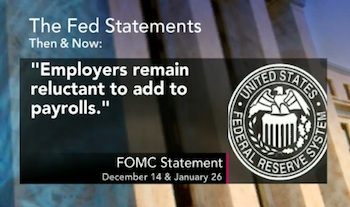Fed: Economy and Jobs Picture Still Unstable. No change to QE2 or overnight rates.
 Below is the statement from the first Fed rate policy of 2011, which shows their view that the economic recovery and jobs situation is still unstable. They left overnight bank to bank lending rates the same at a 0-.25% target, and also said they’d continue their $600b quantitative easing program designed to lower business rates in the economy. This program is known as QE2, since this is the second big program of it’s kind. The first was when the Fed bought 1.25 trillion in mortgage bonds from January 2009 through March 2010 to lower mortgage rates.
Below is the statement from the first Fed rate policy of 2011, which shows their view that the economic recovery and jobs situation is still unstable. They left overnight bank to bank lending rates the same at a 0-.25% target, and also said they’d continue their $600b quantitative easing program designed to lower business rates in the economy. This program is known as QE2, since this is the second big program of it’s kind. The first was when the Fed bought 1.25 trillion in mortgage bonds from January 2009 through March 2010 to lower mortgage rates.
All FOMC members voted for today’s policy action, and Kansas City Fed president Thomas Hoenig the lone dissenter at every FOMC meeting of 2010 was not on the FOMC for 2011 because he’s rotated out. He believes strongly that the Fed needs to ease off of QE2 and raise overnight rates. But this first meeting of 2011 initially shows everyone is in agreement, which isn’t necessarily good for policy setting. But we’ll find out if there’s an actual debate when the full minutes of this meeting are released next month.
FULL FOMC STATEMENT
Information received since the Federal Open Market Committee met in December confirms that the economic recovery is continuing, though at a rate that has been insufficient to bring about a significant improvement in labor market conditions. Growth in household spending picked up late last year, but remains constrained by high unemployment, modest income growth, lower housing wealth, and tight credit. Business spending on equipment and software is rising, while investment in nonresidential structures is still weak. Employers remain reluctant to add to payrolls. The housing sector continues to be depressed. Although commodity prices have risen, longer-term inflation expectations have remained stable, and measures of underlying inflation have been trending downward.
Consistent with its statutory mandate, the Committee seeks to foster maximum employment and price stability. Currently, the unemployment rate is elevated, and measures of underlying inflation are somewhat low, relative to levels that the Committee judges to be consistent, over the longer run, with its dual mandate. Although the Committee anticipates a gradual return to higher levels of resource utilization in a context of price stability, progress toward its objectives has been disappointingly slow.
To promote a stronger pace of economic recovery and to help ensure that inflation, over time, is at levels consistent with its mandate, the Committee decided today to continue expanding its holdings of securities as announced in November. In particular, the Committee is maintaining its existing policy of reinvesting principal payments from its securities holdings and intends to purchase $600 billion of longer-term Treasury securities by the end of the second quarter of 2011. The Committee will regularly review the pace of its securities purchases and the overall size of the asset-purchase program in light of incoming information and will adjust the program as needed to best foster maximum employment and price stability.
The Committee will maintain the target range for the federal funds rate at 0 to 1/4 percent and continues to anticipate that economic conditions, including low rates of resource utilization, subdued inflation trends, and stable inflation expectations, are likely to warrant exceptionally low levels for the federal funds rate for an extended period.
The Committee will continue to monitor the economic outlook and financial developments and will employ its policy tools as necessary to support the economic recovery and to help ensure that inflation, over time, is at levels consistent with its mandate.
Voting for the FOMC monetary policy action were: Ben S. Bernanke, Chairman; William C. Dudley, Vice Chairman; Elizabeth A. Duke; Charles L. Evans; Richard W. Fisher; Narayana Kocherlakota; Charles I. Plosser; Sarah Bloom Raskin; Daniel K. Tarullo; Kevin M. Warsh; and Janet L. Yellen.
